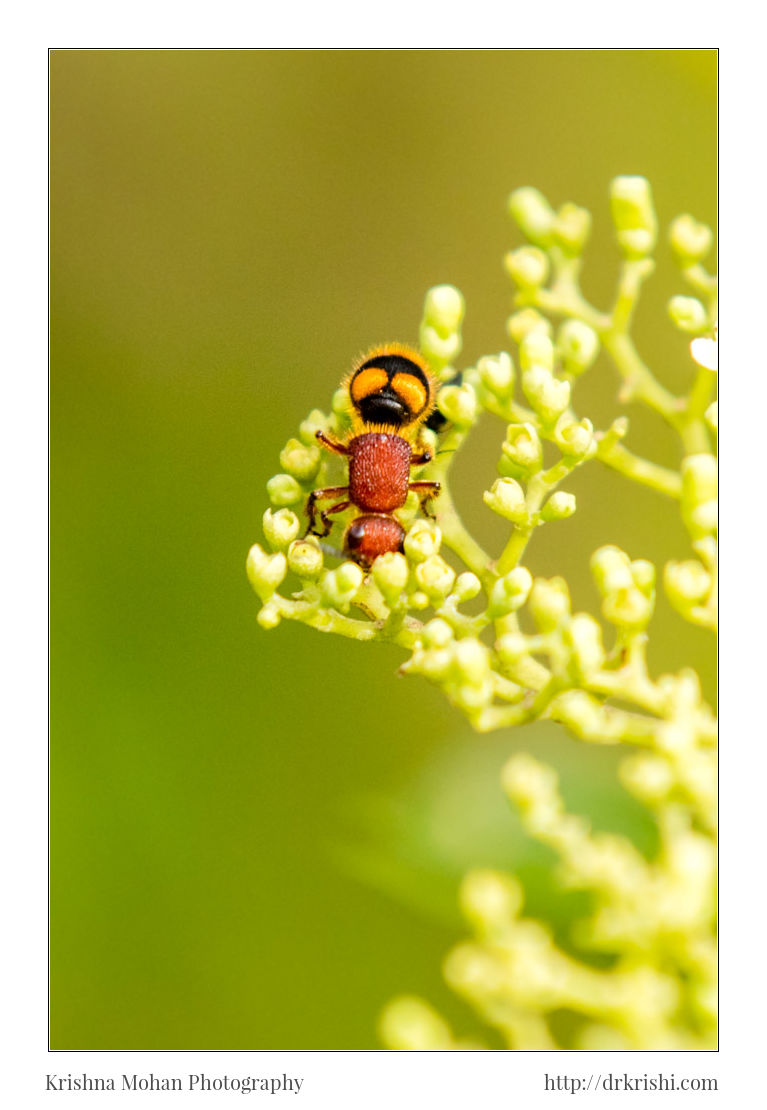
I found this Velvet Ant, at Sammilan Shetty’s Butterfly Park during my review of Canon EOS 5DS R. I used Canon EF 70-200mm f/2.8L IS II USM with Canon EF 2X III Extender. Despite being a non macro lens, the closeup capability of this combination is quite satisfactory. Please note that the images here are all cropped from original dimension.

Insects in the family Mutillidae are often referred to as “velvet ants” because female members of the family lack wings and have coarse setae that cover most of their body, making them resemble hairy ants. These “ants” are actually wasp! A solitary wasp, the velvet ant does not live in colonies or have a “nest”. They are found crawling through lawns, digging around soil. The adult velvet ants feed on nectar and water.

Velvet ants are not aggressive and will try to escape from you. The females have a very painful sting if handled. They are also called “Cow Killer Ant” because of the reputation of the female’s sting. It is said that the sting is so painful that it could kill a cow. This handsome insect does make a sound (especially when stepped on) but the squeaks of the cow killer ant would hardly be heard over the painful screams, if the person stepping on the wasp was barefoot. Black and white specimens are sometimes known as panda ants due to their hair coloration resembling that of the giant panda.
The Mutillidae family contains approximately 230 genera/subgenera and about 8,000 species worldwide. All Mutillidae are solitary parasitoid wasps that mostly attack mature larvae or pupae of other solitary Hymenoptera. However, velvet ants have been observed targeting non-feeding stages of Diptera, Coleoptera, Lepidoptera, Blattodea, and even some eusocial Hymenoptera.

Finding a matching reproductive pair can be difficult, if not impossible for some species, because of the extreme sexual dimorphism displayed within this family. Colour patterns and the relative body size of the two sexes of the same species can be so very different, making it very difficult to relate one sex with the other.
Male Mutillidae are frequently larger (heavier) than the females. Biological data is very scarce and differences obviously exist between genera and species, especially with regards to their life cycles and development, but the following has been reported for most Mutillidae. Females have the difficult job of locating potential hosts. Suitable hosts may be difficult to find for several reasons including: concealment, low population densities when solitary and lastly, if the hosts are eusocial, they will be heavily defended. Once a host is located, female velvet ants parasitize the “hard” life stages (i.e., hardened pre-pupae, pupae, ootheca, eusocial cells, and cocoons) of the hosts and the emerging velvet ant larvae are essentially ectoparasites of those life stages. Once development is completed, adults leave the nest and seek a mate.

All female Mutillidae are wingless and resemble ants. They can easily be differentiated from ants by the lack of petiole nodes, which are present on all ant species. In addition, the mesosomatic (thoracic) segments are completely fused and have at most two segments. The metasoma (abdomen) contains six visible terga (dorsal surface of any body segment) and a “felt line” of dense, closely appressed hairs is located laterally on the second metasomatic tergum (except for the genus Ephuta).
Unlike the female, the male meso and metathorax are not fused and they have three mesosomatic segments. Their metasomal region contains seven visible terga and a felt line is also on the lateral margin of tergite II.
Mutillidae pose no real threat to humans, livestock, or domesticated animals other than the unfortunate accidental sting associated with unaware victims. Like other stinging insects, only female Mutillidae are capable of stinging. Despite assertion as “cow killers” or “mule killers,” they are not aggressive nor is their venom comparatively toxic. Most female mutillids are so docile, they produce a startle response (an audible stridilation) when provoked to warn potential victims of her sting. The LD50 of their venom when exposed to mice is around 71 mg/kg body weight which is relatively non-toxic compared to the very toxic harvester ant, Pogonomyrmex maricopa, venom (LD50 = 0.12 mg/kg) and the moderately toxic honey bee, Apis mellifera, venom (LD50 = 2.8 mg/kg). No control measures are necessary except a safe footwear to avoid accidental sting.


Nice Photos and information Doc.
ಎಂಥದ್ದೋ ಇರುವೇಂತ ತುಳಿದವರಿಗೆ ಮಕ್ಮಲ್ ಟೋಪಿಯೇ (velvet..) ಸರಿ ಈ ಕುಟುಕುವ ಕಣಜದ ಹೆಣ್ಣು 🙁 ಏನಿಲ್ಲಾಂತ ಯಾಣದಲ್ಲಿ ನೀವು ಹಸಿರುಹಾವಿನಿಂದ ಕಡಿಸಿಕೊಂಡು ಸುಮ್ಮನೆ ಉರಿ ಅನುಭವಿಸಿದ ಹಾಗೆ ಇವಳ ಅನುಭವವೂ ಆಗಿದೆಯಾ 🙂
Beautiful photos and info too.
Wish to see the same ant pictures with macro lense..?